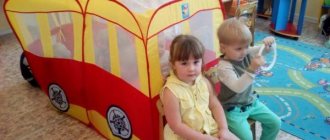"Shop - Supermarket"
The content of the program - forms in children ideas about the work of people in a store, the variety of stores and their purpose. Learn to play different roles depending on the plot of the game. Develop effective visual thinking and communication skills. Cultivate goodwill, the ability to take into account the interests and opinions of gaming partners. Vocabulary words: showcase, cashier, confectionery. Game material: showcase, scales, cash register, bags and baskets for customers, seller’s uniform, money, wallets, goods by department, vehicle for transporting goods, cleaning equipment. “Grocery”: fruit and vegetable dummies, various salt dough pastries, candy dummies, sweets, cookies, cakes, pastries, tea boxes, juices, drinks, sausages, fish, milk cartons, sour cream glasses, yogurt pots, etc. Preparatory work: Conversations with children “What stores are there and what can you buy there?” “Who works in the store?”, “Rules for placing an order.” D / and “Store”, “Vegetables”, “Who is what?”. Reading the poem “Toy Store” by O. Emelyanova. B. Voronko “The History of Unusual Shopping” Making bagels, sandwiches, salt dough cookies, making sweets. Roles: seller, buyer, cashier, store manager, driver. The following scenes are played out: “Bread and confectionery shop (bread shop, shop)” “Vegetable shop (shop)” “Meat and sausage shop (shop)” “Fish shop (shop)” “Dairy shop (shop)” “Gastronomy. “Musical instrument store” “Bookstore” Game actions: The seller puts on a uniform, offers the goods, weighs, packs, puts the goods on the shelves (decorates the display case). The store manager organizes the work of store employees, makes requests for goods, pays attention to the correct work of the seller and cashier, and monitors the order in the store. Buyers come to the store, choose a product, find out the price, consult with sellers, follow the rules of conduct in a public place, line up at the cashier, pay for the purchase at the cash register, and receive a receipt. The cashier receives the money, stamps the check, issues the check, and delivers the change to the customer. The driver delivers a number of different goods, accepts orders from the store manager, and unloads the delivered goods.
What else to read: “Find the right object” - educational game
"Polyclinic"
Program content: To awaken children's interest in the medical profession. Develop the ability to creatively develop the plot of the game. Correct the names of medical instruments: stethoscope, syringe, spatula. Cultivate a sensitive, attentive attitude towards the patient, kindness, reactivity, and a culture of communication. Vocabulary work: phonendoscope, spatula, grafting, vitamins. Game material: doctor's robe and cap, nurse's robe and cap, medical instruments (thermometer, syringe, spatula), bandages, green material, cotton wool, mustard plasters, patient cards, vitamins. Preparatory work: Tour of the doctor’s office d/s. Watching the doctor work. Reading fiction: J. Rainis “The Doll Got Sick”, V. Berestov “The Sick Doll”. A. Barto “Tamara and I”, P. Obraztsov “I’m flying on a doll”, A. Kardashova “Our Doctor”. Production "The Animals Are Sick". I’m watching the album “Playing the Doctor.” Create attributes for the game. Conversations with children “We are being treated by a doctor and a nurse”, “How to behave in a doctor’s office?” Roles: doctor, nurse, patient. Stories are played out: “At the doctor’s appointment”, “Call the doctor at home” “Hurt your finger” “Sore throat” “Give an injection” “Get a vaccine” Actions in the game: The doctor receives patients, listens carefully to their complaints, asks questions, listens , looks at the throat, makes an appointment. The nurse gives injections, medicines, vitamins, applies mustard plasters, lubricates wounds and bandages. The patient comes to the doctor, tells him what worries him, and follows the doctor’s recommendations.




